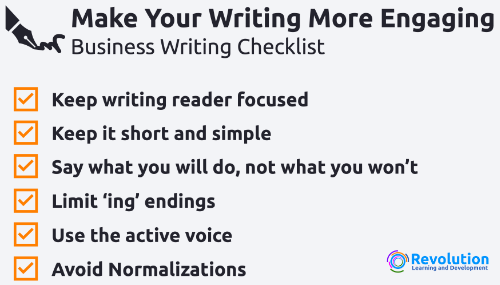Why Make Writing More Positive and Engaging
Whether you are writing a blog post, an email to a customer or a report, it pays to make your writing more positive and Engaging.
Positive writing is much more engaging and gives a much better all-around feeling for the reader.
What is Negative Writing?
Negative writing is when the language that is used in writing is viewed as negative. We use negative words over positive.
Examples of negative words we could use are:
- No
- Not
- Won’t
- Can’t
- Unable to
We also may use negative statements such as:
- Fell short
- Didn’t meet expectations
- Nothing we can do
Not commital words can also be seen to be negative. Words and statements such as:
- Possibly
- Could
- Maybe
- Might
- Try
How to Make Writing More Positive
The idea is to consider the structure of your writing and aim to make things more positive. Here are some examples:
Negative – The system probably won’t be up and running until next Tuesday
Positive – The system will be up and running by next Tuesday.
Negative – I’m sorry that the website fell short of your expectations.
Positive – I appreciate the suggestions you sent about ways to improve the website.
Negative – We are unable to reserve advertising space until 15th September.
Positive – We can reserve advertising space from 15th September.
Use a positive, decisive version of verbs: e.g. use ‘ask’ not ‘enquire’; ‘think’ rather than ‘believe’; ‘know’ rather than ‘feel’.
Here are some other words that pack a positive punch:
- Benefit
- Bonus
- Excellent
- Delighted
- Honest
- Guarantee
- Immediately
- Of course
- Yes
- Thank you
These have negative connotations:
- Regret
- Problem
- Impossible
- Cannot
- Complaint
- Delay
- Mistake
- Sorry
- Disappoint
- Difficulty
When you are writing content, take some time to read back over what you have written and consider if there are ways to make what you have written more positive.
How to Make Writing More Engaging
The Plain English Campaign is a great resource for tips and ideas for business writing. We use some of their guidance in our business writing skills training courses.
We all want to be able to write quickly while still being able to get the message and understanding across. We also want to engage the reader.

- Keep writing reader-focused
- Keep it short and simple (K.I.S.S.) and choose decisive words
- Say what you can and will do, not what you can’t and won’t do
- Limit ‘ing’ endings to verbs
- Use the active voice at least 80% of the time
- Avoid nominalizations.
Reader Focused
Don’t be afraid to use I, we and you where appropriate in letters, emails and reports to personalise writing. Communication is to people, not departments. Phrase as much text as possible from your readers’ viewpoint.
K.I.S.S
Look for simple single syllable verbs: ‘go’ not ‘proceed’, ‘send’ not ‘transmit’. These are quicker to read and understand. Use a positive, decisive version of the verb: ‘ask’ not ‘enquire’; ‘know’ rather than ‘feel’.
Say What You Will Do
Put a positive spin on your writing. Positive words trigger positive responses, and positive sentences are shorter and more compelling to read. Use a positive, decisive version of verbs: e.g. use ‘ask’ not ‘enquire’; ‘think’ rather than ‘believe’; ‘know’ rather than ‘feel’.
Limit ‘ing’ Endings
Try not to use the present tense in the ‘–ing’ form. For example, rather than ‘We are committed to delivering’ use ‘We will Deliver’ or, rather than ‘One of our objectives is reducing costs’ use ‘To reduce costs is one of our objectives’.
Use the Active Voice
This required reordering of words to make them more active. Instead of ‘The TV was watched by Peter’ which is passive, use ‘Peter watched the TV’. It’s less stuffy and shorter to read and write. Another example – ‘Peter was crushed by the tree’ is passive. ‘The tree crushed Peter’ is active.
Avoid Nominalizations
A nominalisation is a result of turning a verb into a noun. As with the passive voice, nominalisations increase the length and complexity of the sentence. For example, ‘Users should ensure they are in compliance with the regulations’ includes a nominalization where ‘Users must comply with the regulations’ doesn’t.
Making writing more active, reader-focused and easier to read will go a long way to making your writing more engaging.
Business Writing Skills Training Course
Our Business Writing Skills course provides lots of tips and ideas on how to make your writing more positive and engaging.




